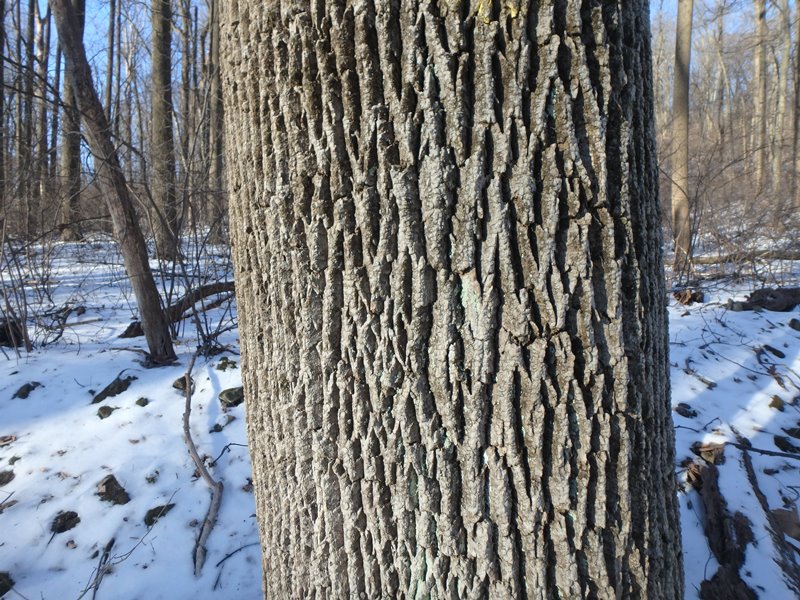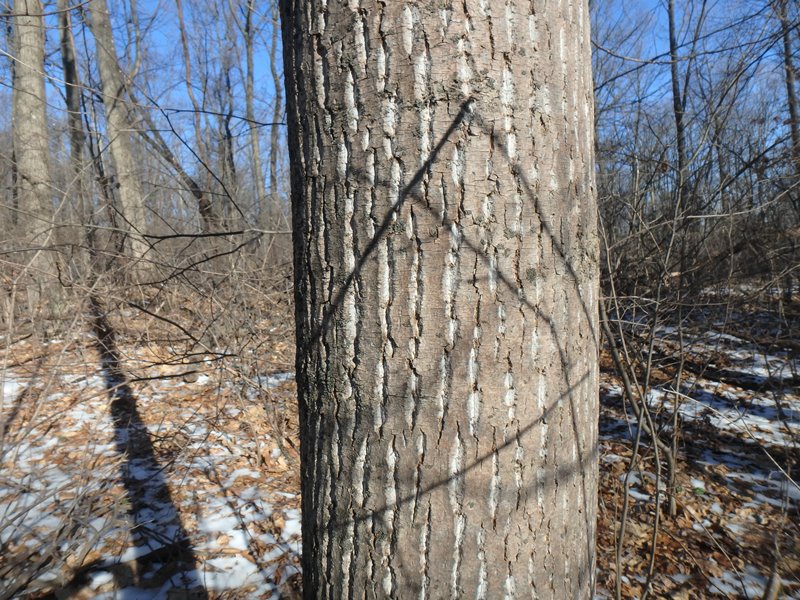ID Tuliptrees and White Ash By Their Bark
March 25, 2020
Tulip Tree in winter
by Tim Burris, preserve manager.
I am returning to looking at tree bark.
Let’s look at two tree species that are probably the hardest in our area to tell apart by their bark. Tuliptree (Lireodendron tulipifera) is a common tree in Natural Lands’ forests. It is also known as Tulip Poplar and Yellow Poplar, but it is actually in the magnolia family. (I prefer to call it Tuliptree, because for me poplar will always refer to the aspens which are in the poplar family.)

Tuliptree bark
Tuliptree has a bark that I call “ridge and valleys with diamonds”. Imagine looking from space at one mountain chain after another with little diamond shaped valleys between the criss-crossed ridges.

White Ash bark. There is a subtle difference.
White Ash (Fraxinus americana) has the same type of “ridge and valley with diamonds” bark. These two species are often found together, which makes it even more challenging to tell them apart. I need to look at the whole tree to be positive, but I can usually distinguish them at eye level (but then I’ve looked at tens of thousands of them over the last 40 years). When they are in leaf it is a very easy.
If you look at the White Ash above, you will see that it is a little grayer in tone. The Tuliptree is more brown. That is a pretty subtle difference. Another subtle difference is that the ridges are a little more peaked in the White Ash and a little flatter in the Tuliptree.

A younger Tuliptree.
Stepping back, I will look at the whole trunk of a leafless tree. Tuliptrees seem to be more cylindrical, while Ash trees start tapering inward from the ground. I know that is pretty subtle too.

An older Tuliptree. The ridges are getting flatter.
The real giveaway is the straightness of the trunk. Tuliptrees are different than a lot of species because they grow away from Earth’s gravity instead of toward the sun. Because of that growth characteristic they have straightness that you don’t find in other tree species. Even when they have been hit by lightning or had the terminal bud broken, you will see other branches respond by turning straight up away from Earth. White ashes grow straight also, but don’t seem to grow as straight as a Tuliptree. Finally, there is a very different pattern when you look at the branches against the sky.
Of course, right now most of our White Ash trees are dying because of a non-native insect called the Emerald Ash Borer. Dan and I have both written quite a bit about this insect and its affects in these Field Notes.
next post
82 Acres Added to Crow's Nest Preserve
March 23, 2020
Natural Lands announced today it has purchased an 82-acre wooded property adjacent to its Crow’s Nest Preserve in Warwick Township, Chester County.
